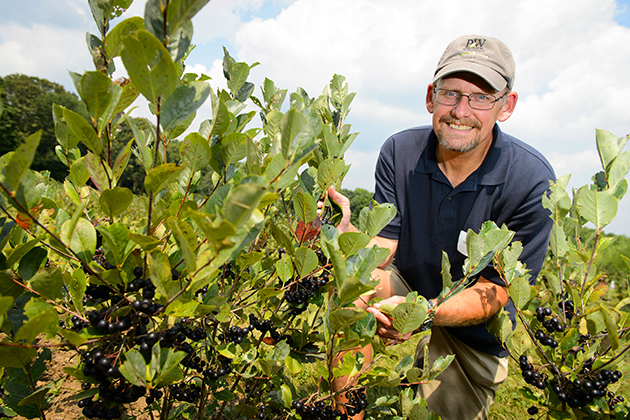In traditional laboratory settings and at the plant science research farm off Route 195, University of Connecticut researchers are exploring the multitude of possibilities inherent in a plump, purplish-black berry, the aronia.
Mark Brand, professor of horticulture in the Department of Plant Science and Landscape Architecture in the College of Agriculture and Natural Resources (CANR) says aronia promises benefits on several fronts. “It’s a native plant so we know it grows well in New England,” he says. “The berries can be consumed in a variety of ways, they’re really high in

anti-oxidants so they have strong neutraceutical benefits, and the bushes themselves can be grown by the horticulture industry and sold to landscapers and homeowners for use as attractive ornamental plants.”
Brand is currently working with a germplasm collection that includes 100 wild genotypes from 23 states. He is seeking to maximize the form, flavor, and function of the aronia, with hopes of giving it a more prominent place alongside other native, fruit-bearing plants such as cranberries and blueberries.
This fruit, born by the native shrub Aronia melanocarpa, is also known as the chokeberry. Widely known in the eastern US, it was exported to Europe early in the 20th century where it subsequently became established as a commercially viable crop. Currently, over 50 percent of the world’s aronia berry production takes place in Poland.
Commercial Potential
In the United States, where the berry is abundant in the wild, widespread commercial exploitation has been slower to come. However, UConn scientists, aided in part by a $152,000 grant from the Northeast Sustainable Agriculture Research & Education (SARE) program, are working to change that.

Recently, Brand hosted a seminar on campus where potential growers could get an idea of the promises inherent in the plant. The seminar, “A New Fruit Crop for the Northeast”, held in cooperation with Northeast SARE and the University of Maine cooperative extension services, sought to introduce potential growers to both the challenges and the potential rewards of growing aronia.
Among those making presentations was Allyn Brown, ’78, a graduate of CANR’s Ratcliffe Hicks School of Agriculture where he majored in nursery management. Brown is the largest grower of blackcurrants in North America and his bottling facility ships hundreds of thousands of gallons of the juice annually to supermarkets throughout the northeast and mid-Atlantic states.
Brown has been experimenting with growing the aronia which is similar to the blackcurrant in many respects. He talked about establishing a market for the native berry, while acknowledging that most in attendance at the seminar would probably start small and focus on local distribution rather than entering into large commercial production.
Like Brand, he is favorably impressed with the aronia’s hardiness and versatility as both a food product and an ornamental shrub.
“Growing it [the aronia] has its challenges,” he said, “and the fact that deer like it as an appetizer doesn’t help, but it’s native to the region and prospers during our normally cold winters.” Brown added that the aronia is a versatile crop because it can be marketed as a drink or sold as preserves or in baked goods and it also has ornamental value as a shrub.
Since the berries are high in tannins, their taste right off the bush may be off-putting for some, who find it bitter. But with processing – either chilling or cooking – the taste becomes highly palatable. One of the things Brand is attempting to develop is a fruit that still contains the high levels of anti-oxidants for which the aronia is known, but that doesn’t taste quite so bitter when it comes directly from the bush.
Neutraceutical Benefits
Meanwhile, in his laboratory, assistant professor in the Department of Nutritional Sciences (CANR) Bradley Bolling is studying how dietary polyphenols, a group of chemicals with antioxidant properties, found in aronia may be used to reduce the risk and complications of chronic conditions such as inflammatory bowel disease (IBD).

Bolling is working with Brand to determine which aronia genotypes will have the greatest effect in inhibiting the auto-immune response that leads to the chronic inflammation in the gastro-intestinal tract that characterizes IBD.
Additionally, thanks to a grant of $417,000 from the state’s Biomedical Research Trust Fund for the study of diseases and chronic illnesses associated with tobacco use, Bolling is also investigating whether or not aronia polyphenols may reduce cardiovascular disease risk in former smokers.
“Our hypothesis is that chokeberry [aronia] polyphenols will improve cholesterol levels and inhibit inflammation and oxidative stress in this population,” he says.
Previous clinical studies demonstrating that aronia consumption lowers high blood cholesterol led to a USDA Hatch funded project that Bolling is working on with Jiyoung Lee, associate professor in Nutritional Sciences. Using both animal and cellular models, the researchers are investigating just how aronia polyphenols work to lower cholesterol levels in humans.
Looking Ahead
Brand sums it up by saying, “Of all the new fruit crops people are looking at right now, aronia is the one with the greatest potential. It beats out currants, gooseberries, and elderberries. Some of the things that make it stand out are its low input requirements, high adaptability, high nutraceutical content, short time to first yield, ease of culture, and high machine harvest potential. All these attributes put it at the top of the list for commercial production potential.”
He concludes,”Hopefully, UConn breeding work and nutritional studies will give aronia the momentum it needs to become a prominent fruit crop in North America.”
_______________________________________________________
For anyone interested in Dr. Bolling’s research studies, further information is available on the Department of Nutrition Website.



